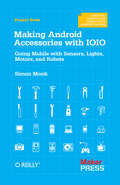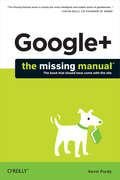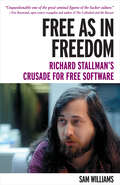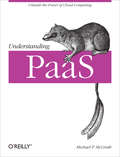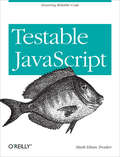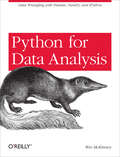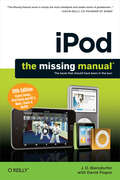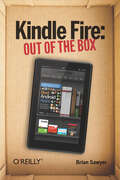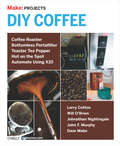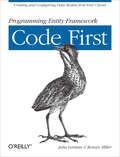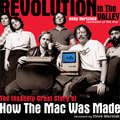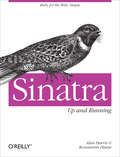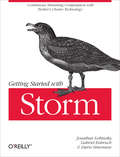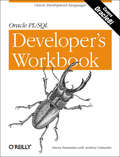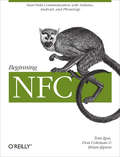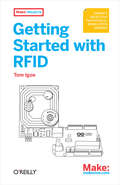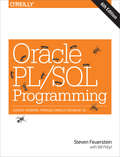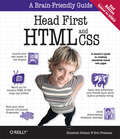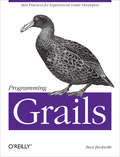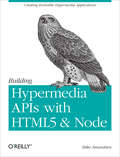- Table View
- List View
Making Android Accessories with IOIO
by Simon MonkCreate your own electronic devices with the popular IOIO ("yoyo") board, and control them with your Android phone or tablet. With this concise guide, you'll get started by building four example projects--after that, the possibilities for making your own fun and creative accessories with Android and IOIO are endless. To build Android/IOIO devices, you write the program on your computer, transfer it to your Android, and then communicate with the IOIO via a USB or Bluetooth connection. The IOIO board translates the program into action. This book provides the source code and step-by-step instructions you need to build the example projects. All you have to supply is the hardware. Learn your way around the IOIO and discover how it interacts with your Android Build an intruder alarm that sends a text message when it detects movement Make a temperature sensing device that logs readings on your Android Create a multicolor LED matrix that displays a Space Invader animation Build an IOIO-powered surveillance rover that you control with your Android Get the software and hardware requirements for creating your own Android/IOIO accessories
Making Android Accessories with IOIO: Going Mobile with Sensors, Lights, Motors, and Robots
by Simon MonkCreate your own electronic devices with the popular IOIO ("yoyo") board, and control them with your Android phone or tablet. With this concise guide, you’ll get started by building four example projects—after that, the possibilities for making your own fun and creative accessories with Android and IOIO are endless.To build Android/IOIO devices, you write the program on your computer, transfer it to your Android, and then communicate with the IOIO via a USB or Bluetooth connection. The IOIO board translates the program into action. This book provides the source code and step-by-step instructions you need to build the example projects. All you have to supply is the hardware.Learn your way around the IOIO and discover how it interacts with your AndroidBuild an intruder alarm that sends a text message when it detects movementMake a temperature sensing device that logs readings on your AndroidCreate a multicolor LED matrix that displays a Space Invader animationBuild an IOIO-powered surveillance rover that you control with your AndroidGet the software and hardware requirements for creating your own Android/IOIO accessories
Google+: The Missing Manual
by Kevin PurdyIf you want to gain more control over your social networking activities with Google+, this jargon-free guide helps you quickly master the ins and outs of the site. Learn how to organize your contacts, hold video chats with as many as ten people, and determine exactly who may learn what about you. With this book, you'll navigate Google+ with ease. The important stuff you need to know Massage your profile. Control what the public, specific groups, or certain individuals can see about you. Move in the right circles. Assign folks to different groups and share the right stuff with the right people. Jump into streams. Get all the updates, pictures, and links from people you know. Host hangouts. Organize and attend group video chats. View and share photos. Make them available to whomever you like--whether or not they're Google+ members. Get notifications. Monitor what others do (and share about you) on Google+. Go mobile. Use Google+ on your Android, iPhone, or mobile web browser.
Google+: The Missing Manual (Oreilly And Associate Ser.)
by Kevin PurdyIf you want to gain more control over your social networking activities with Google+, this jargon-free guide helps you quickly master the ins and outs of the site. Learn how to organize your contacts, hold video chats with as many as ten people, and determine exactly who may learn what about you. With this book, you’ll navigate Google+ with ease.The important stuff you need to knowMassage your profile. Control what the public, specific groups, or certain individuals can see about you.Move in the right circles. Assign folks to different groups and share the right stuff with the right people.Jump into streams. Get all the updates, pictures, and links from people you know.Host hangouts. Organize and attend group video chats.View and share photos. Make them available to whomever you like—whether or not they’re Google+ members.Get notifications. Monitor what others do (and share about you) on Google+.Go mobile. Use Google+ on your Android, iPhone, or mobile web browser.
Free as in Freedom [Paperback]: Richard Stallman's Crusade for Free Software
by Sam WilliamsFree as in Freedom interweaves biographical snapshots of GNU project founder Richard Stallman with the political, social and economic history of the free software movement. It examines Stallman's unique personality and how that personality has been at turns a driving force and a drawback in terms of the movement's overall success.Free as in Freedom examines one man's 20-year attempt to codify and communicate the ethics of 1970s era "hacking" culture in such a way that later generations might easily share and build upon the knowledge of their computing forebears. The book documents Stallman's personal evolution from teenage misfit to prescient adult hacker to political leader and examines how that evolution has shaped the free software movement. Like Alan Greenspan in the financial sector, Richard Stallman has assumed the role of tribal elder within the hacking community, a community that bills itself as anarchic and averse to central leadership or authority. How did this paradox come about? Free as in Freedom provides an answer. It also looks at how the latest twists and turns in the software marketplace have diminished Stallman's leadership role in some areas while augmenting it in others.Finally, Free as in Freedom examines both Stallman and the free software movement from historical viewpoint. Will future generations see Stallman as a genius or crackpot? The answer to that question depends partly on which side of the free software debate the reader currently stands and partly upon the reader's own outlook for the future. 100 years from now, when terms such as "computer," "operating system" and perhaps even "software" itself seem hopelessly quaint, will Richard Stallman's particular vision of freedom still resonate, or will it have taken its place alongside other utopian concepts on the 'ash-heap of history?'
Understanding PaaS
by Michael P. Mcgrath<p>Cloud computing is the most rapidly growing segment of information technology today. The largest enterprises and the newest start-ups are all working interesting and unique cloud strategies. At the heart of this growth is the newest and most misunderstood segment of cloud computing: Platform as a Service.<br/><br/>\nThis book describes how to best utilize PaaS as a way to solve old and new technology problems. Innovation has become a normal part of business and PaaS takes that innovation to the next level by significantly lowering cost, overhead, and maintenance requirements. Information Technology is fun and exciting again, "Understanding PaaS" will show you how to get started.</p>
Understanding PaaS: Unleash the Power of Cloud Computing (Oreilly And Associate Ser.)
by Michael P. McgrathThe least understood feature of cloud computing, Platform as a Service (PaaS), is also the most powerful and cost effective. This concise overview shows you why organizations that properly wield PaaS can quickly gain a strong competitive advantage. You’ll learn how PaaS enables developers to pursue low cost R&D projects, lets system administrators focus on systems rather than servers, and helps architects evaluate new technology quickly and directly.Many reliable PaaS providers are available today, including services from Amazon, Red Hat, and Google. This book offers valuable advice for technically and not-so-technically minded people who want to understand how PaaS can change the way organizations do computing.Get rudimentary examples of how to initiate projects with a typical PaaS providerConsider language selection, feature set, and general capabilities when evaluating a PaaS solutionAutomate tasks like continuous integration, unit tests, and buildsLearn how to design applications by understanding how PaaS works under the hoodDiscover the critical difference between scaling up and scaling outAnticipate subtle but important differences between traditional computing and PaaS computingChange the way you think about security in the cloud
Testable JavaScript: Ensuring Reliable Code
by Mark Ethan TrostlerOne skill that’s essential for any professional JavaScript developer is the ability to write testable code. This book shows you what writing and maintaining testable JavaScript for the client- or server-side actually entails, whether you’re creating a new application or rewriting legacy code.From methods to reduce code complexity to unit testing, code coverage, debugging, and automation, you’ll learn a holistic approach for writing JavaScript code that you and your colleagues can easily fix and maintain going forward. Testing JavaScript code is complicated. This book helps experienced JavaScript developers simply the process considerably.Get an overview of Agile, test-driven development, and behavior-driven developmentUse patterns from static languages and standards-based JavaScript to reduce code complexityLearn the advantages of event-based architectures, including modularity, loose coupling, and reusabilityExplore tools for writing and running unit tests at the functional and application levelGenerate code coverage to measure the scope and effectiveness of your testsConduct integration, performance, and load testing, using Selenium or CasperJSUse tools for in-browser, Node.js, mobile, and production debuggingUnderstand what, when, and how to automate your development processes
Python for Data Analysis
by Wes Mckinney<p>Despite the explosive growth of data in industry after industry, learning and accessing data analysis tools has remained a challenge. This pragmatic guide demonstrates the nuts and bolts of manipulating, processing, cleaning, and crunching data with Python. It also serves as a modern introduction to scientific computing in Python for data-intensive applications.</p>
iPod: The Missing Manual, Tenth Edition
by J. D. Biersdorfer<p>Get the complete scoop the latest line of iPods and the most recent version of iTunes with the guide that outshines them all—<i>iPod: The Missing Manual</i>. Teeming with high-quality color graphics, this books helps you manage your media, play back music, videos, and photo slideshows, and keep your calendars and contacts up-to-date. Whether you have a brand-new iPod or an old favorite, this book provides expert guidance on all the amazing things you can do.</p>
Kindle Fire: Out of the Box
by Brian SawyerWhen you open the box for your brand-new Kindle Fire, you'll find the hottest 7-inch tablet to hit the market, a power adapter, and a "Quick Start Guide" that tells you how to turn it on. But to really take advantage of all the content and features the device has to offer, you'll need a little more. Kindle Fire: Out of the Box gets you up and running beyond the first "Slide to unlock" screen to unlock all of your media from the cloud in the palm of your hand.Whether your media library lives in Amazon Cloud Drive or on your device, the Fire gives you immediate access to all of it, wherever you are, as long as you know where to find it and how to consume it. With Kindle Fire: Out of the Box, you'll jump right in to reading full-color magazines, newspapers, newly enhanced ebooks, and your own personal documents. Quickly download music from your Amazon Cloud Drive or new music from the Amazon MP3 store to listen offline, and get instant, unlimited access to streaming of over 10,000 popular movies and TV shows. And go beyond your own media to experience integrated email, games, Android apps from the Amazon App Store, and ultra-fast web browsing with the revolutionary, cloud-accelerated Silk browser.This intuitive, easy-to-follow ebook opens the world of possibilities made possible by the Kindle Fire, right out of the box.
DIY Coffee: Coffee Roaster, Bottomless Portafilter, Toaster Tea Popper, Hot on the Spot, Automate Using X10
by Mark FrauenfelderDIY Coffee collects five hot MAKE magazine projects to supercharge your java: Home-Built Coffee Roaster Bottomless Espresso Portafilter Toaster Tea Popper Perfect Espresso Temperature Hack Web-Fired Coffee with X10 AutomationGot a jones for caffeine and technology? Mod your espresso machine to dial in the perfect shot, with precise temperature control and a filter hack that kicks out maximum tasty crema. Roast your own with a hand-built custom coffee roaster. Hack a toaster timer to perfect-brew your tea every time. And fire up your coffee pot from the internet using X10 automation. Using home-grown techniques and off-the-shelf parts, caffeine junkies will find everything they need to overclock the fix from their favorite shade-grown beverage.
Programming Entity Framework: Creating and Configuring Data Models from Your Classes
by Julia Lerman Rowan MillerTake advantage of the Code First data modeling approach in ADO.NET Entity Framework, and learn how to build and configure a model based on existing classes in your business domain. With this concise book, you’ll work hands-on with examples to learn how Code First can create an in-memory model and database by default, and how you can exert more control over the model through further configuration.Code First provides an alternative to the database first and model first approaches to the Entity Data Model. Learn the benefits of defining your model with code, whether you’re working with an existing database or building one from scratch. If you work with Visual Studio and understand database management basics, this book is for you.Learn exactly what Code First does—and does not—enable you to doUnderstand how property attributes, relationships, and database mappings are inferred from your classes by Code FirstUse Data Annotations and the Fluent API to configure the Code First data modelPerform advanced techniques, such as controlling the database schema and overriding the default model cachingThis book is a continuation of author Julia Lerman’s Programming Entity Framework, widely recognized as the leading book on the topic.
Revolution in The Valley [Paperback]: The Insanely Great Story of How the Mac Was Made
by Andy HertzfeldThere was a time, not too long ago, when the typewriter and notebook ruled, and the computer as an everyday tool was simply a vision. Revolution in the Valley traces this vision back to its earliest roots: the hallways and backrooms of Apple, where the groundbreaking Macintosh computer was born. The book traces the development of the Macintosh, from its inception as an underground skunkworks project in 1979 to its triumphant introduction in 1984 and beyond.The stories in Revolution in the Valley come on extremely good authority. That's because author Andy Hertzfeld was a core member of the team that built the Macintosh system software, and a key creator of the Mac's radically new user interface software. One of the chosen few who worked with the mercurial Steve Jobs, you might call him the ultimate insider.When Revolution in the Valley begins, Hertzfeld is working on Apple's first attempt at a low-cost, consumer-oriented computer: the Apple II. He sees that Steve Jobs is luring some of the company's most brilliant innovators to work on a tiny research effort the Macintosh. Hertzfeld manages to make his way onto the Macintosh research team, and the rest is history.Through lavish illustrations, period photos, and Hertzfeld's vivid first-hand accounts, Revolution in the Valley reveals what it was like to be there at the birth of the personal computer revolution. The story comes to life through the book's portrait of the talented and often eccentric characters who made up the Macintosh team. Now, over 20 years later, millions of people are benefiting from the technical achievements of this determined and brilliant group of people.
Sinatra: Ruby for the Web, Simply
by Alan Harris Konstantin HaaseTake advantage of Sinatra, the Ruby-based web application library and domain-specific language used by Heroku, GitHub, Apple, Engine Yard, and other prominent organizations. With this concise book, you will quickly gain working knowledge of Sinatra and its minimalist approach to building both standalone and modular web applications.Sinatra serves as a lightweight wrapper around Rack middleware, with syntax that maps closely to functions exposed by HTTP verbs, which makes it ideal for web services and APIs. If you have experience building applications with Ruby, you’ll quickly learn language fundamentals and see under-the-hood techniques, with the help of several practical examples. Then you’ll get hands-on experience with Sinatra by building your own blog engine.Learn Sinatra’s core concepts, and get started by building a simple applicationCreate views, manage sessions, and work with Sinatra route definitionsBecome familiar with the language’s internals, and take a closer look at RackUse different subclass methods for building flexible and robust architecturesPut Sinatra to work: build a blog that takes advantage of service hooks provided by the GitHub API
Getting Started with Storm
by Jonathan Leibiusky Gabriel Eisbruch Dario Simonassi<p>Even as data is turning the world upside down, the next revolution is taking shape: realtime data analysis. Data tools like Hadoop are batch-oriented; they're good at taking a set of data, analyzing it, and giving you the result later. But these tools are not particularly good at handling streaming data: data that is constantly arriving, and results that are changing as fast as the data arrives. Storm is a new tool that solves that problem. This book gets you started with it.</p>
Getting Started with Storm: Continuous Streaming Computation with Twitter's Cluster Technology
by Jonathan Leibiusky Gabriel Eisbruch Dario SimonassiEven as big data is turning the world upside down, the next phase of the revolution is already taking shape: real-time data analysis. This hands-on guide introduces you to Storm, a distributed, JVM-based system for processing streaming data. Through simple tutorials, sample Java code, and a complete real-world scenario, you’ll learn how to build fast, fault-tolerant solutions that process results as soon as the data arrives.Discover how easy it is to set up Storm clusters for solving various problems, including continuous data computation, distributed remote procedure calls, and data stream processing.Learn how to program Storm components: spouts for data input and bolts for data transformationDiscover how data is exchanged between spouts and bolts in a Storm topologyMake spouts fault-tolerant with several commonly used design strategiesExplore bolts—their life cycle, strategies for design, and ways to implement themScale your solution by defining each component’s level of parallelismStudy a real-time web analytics system built with Node.js, a Redis server, and a Storm topologyWrite spouts and bolts with non-JVM languages such as Python, Ruby, and Javascript
Oracle PL/SQL Programming: A Developer's Workbook
by Steven Feuerstein Andrew OdewahnHowever excellent they are, most computer books are inherently passive--readers simply take in text without having any opportunity to react to it. The Oracle PL/SQL Developer's Workbook is a different kind of animal! It's designed to engage you actively, to get you solving programming problems immediately, and to help you apply what you've learned about PL/SQL--and in the process deepen your knowledge of the language. By tackling the exercises in this workbook, you'll find yourself moving more rapidly along the learning curve to join the growing ranks of PL/SQL experts. The Oracle PL/SQL Developer's Workbook is a companion to Steven Feuerstein's bestselling Oracle PL/SQL Programming and his other PL/SQL books from O'Reilly. It contains a carefully constructed set of problems and solutions that will test your language skills and help you become a better developer--both with PL/SQL and with other languages. Exercises are provided at three levels: beginner, intermediate, and expert. The workbook exercises cover all the major features of PL/SQL, including those new to Oracle8i (e.g., Java and web features, autonomous transactions, and bulk binds). You'll find chapters on: Basic language elements--variables, naming, loops, conditional and sequential control, exception handling, and records. Data structures--index-by tables, nested tables, variables arrays (VARRAYs), and object technology. Database interaction--cursors, DML and transaction management, cursor variables, and native dynamic SQL Program construction--procedures, functions, blocks, packages, database triggers, and calling PL/SQL functions in SQL. Built-in functionality--the character, date, conversion, numeric, and miscellaneous functions, and the DBMS_SQL, DBMS_PIPE, DBMS_OUTPUT, UTL_FILE, and DBMS_JOB built-in packages. Miscellaneous topics--using Java with PL/SQL, external programs, PL/SQL web development, tuning PL/SQL, and PL/SQL for DBAs.
Oracle PL/SQL Programming: Oracle Development Languages
by Steven Feuerstein Andrew OdewahnHowever excellent they are, most computer books are inherently passive--readers simply take in text without having any opportunity to react to it. The Oracle PL/SQL Developer's Workbook is a different kind of animal! It's designed to engage you actively, to get you solving programming problems immediately, and to help you apply what you've learned about PL/SQL--and in the process deepen your knowledge of the language. By tackling the exercises in this workbook, you'll find yourself moving more rapidly along the learning curve to join the growing ranks of PL/SQL experts.The Oracle PL/SQL Developer's Workbook is a companion to Steven Feuerstein's bestselling Oracle PL/SQL Programming and his other PL/SQL books from O'Reilly. It contains a carefully constructed set of problems and solutions that will test your language skills and help you become a better developer--both with PL/SQL and with other languages. Exercises are provided at three levels: beginner, intermediate, and expert. The workbook exercises cover all the major features of PL/SQL, including those new to Oracle8i (e.g., Java and web features, autonomous transactions, and bulk binds).You'll find chapters on:Basic language elements--variables, naming, loops, conditional and sequential control, exception handling, and records.Data structures--index-by tables, nested tables, variables arrays (VARRAYs), and object technology.Database interaction--cursors, DML and transaction management, cursor variables, and native dynamic SQLProgram construction--procedures, functions, blocks, packages, database triggers, and calling PL/SQL functions in SQL.Built-in functionality--the character, date, conversion, numeric, and miscellaneous functions, and the DBMS_SQL, DBMS_PIPE, DBMS_OUTPUT, UTL_FILE, and DBMS_JOB built-in packages.Miscellaneous topics--using Java with PL/SQL, external programs, PL/SQL web development, tuning PL/SQL, and PL/SQL for DBAs.
Beginning NFC: Near Field Communication with Arduino, Android, and PhoneGap
by Brian Jepson Tom Igoe Don ColemanJump into the world of Near Field Communications (NFC), the fast-growing technology that lets devices in close proximity exchange data, using radio signals. With lots of examples, sample code, exercises, and step-by-step projects, this hands-on guide shows you how to build NFC applications for Android, the Arduino microcontroller, and embedded Linux devices.You’ll learn how to write apps using the NFC Data Exchange Format (NDEF) in PhoneGap, Arduino, and node.js that help devices read messages from passive NFC tags and exchange data with other NFC-enabled devices. If you know HTML and JavaScript, you’re ready to start with NFC.Dig into NFC’s architecture, and learn how it’s related to RFIDWrite sample apps for Android with PhoneGap and its NFC pluginDive into NDEF: examine existing tag-writer apps and build your ownListen for and filter NDEF messages, using PhoneGap event listenersBuild a full Android app to control lights and music in your homeCreate a hotel registration app with Arduino, from check-in to door lockWrite peer-to-peer NFC messages between two Android devicesExplore embedded Linux applications, using examples on Raspberry Pi and BeagleBone
Getting Started with RFID: Identify Objects in the Physical World with Arduino
by Tom IgoeIf you want to experiment with radio frequency identification (RFID), this book is the perfect place to start. All you need is some experience with Arduino and Processing, the ability to connect basic circuits on a breadboard with jumper wire—and you’re good to go. You’ll be guided through three hands-on projects that let you experience RFID in action.RFID is used in various applications, such as identifying store items or accessing a toll road with an EZPass system. After you build each of the book’s projects in succession, you’ll have the knowledge to pursue RFID applications of your own.Use Processing to get a sense of how RFID readers behaveConnect Arduino to an RFID reader and discover how to use RFID tags as keysAutomate your office or home, using RFID to turn on systems when you’re present, and turn them off when you leaveGet a complete list of materials you need, along with code samples and helpful illustrationsTackle each project with easy-to-follow explanations of how the code works
Oracle PL/SQL Programming: Covers Versions Through Oracle Database 12c
by Steven Feuerstein Bill PribylConsidered the best Oracle PL/SQL programming guide by the Oracle community, this definitive guide is precisely what you need to make the most of Oracle’s powerful procedural language. The sixth edition describes the features and capabilities of PL/SQL up through Oracle Database 12c Release 1.Hundreds of thousands of PL/SQL developers have benefited from this book over the last twenty years; this edition continues that tradition. With extensive code examples and a lively sense of humor, this book explains language fundamentals, explores advanced coding techniques, and offers best practices to help you solve real-world problems.Get PL/SQL programs up and running quickly, with clear instructions for executing, tracing, testing, debugging, and managing codeUnderstand new 12.1 features, including the ACCESSIBLE_BY clause, WITH FUNCTION and UDF pragma, BEQUEATH CURRENT_USER for views, and new conditional compilation directivesTake advantage of extensive code samples, from easy-to-follow examples to reusable packaged utilitiesOptimize PL/SQL performance with features like the function result cache and Oracle utilities such as PL/Scope and the PL/SQL hierarchical profilerBuild modular, easy-to-maintain PL/SQL applications using packages, procedures, functions, and triggers
Head First HTML and CSS: A Learner's Guide to Creating Standards-Based Web Pages (Oreilly And Associate Ser.)
by Eric Freeman Elisabeth RobsonTired of reading HTML books that only make sense after you're an expert? Then it's about time you picked up Head First HTML and really learned HTML. You want to learn HTML so you can finally create those web pages you've always wanted, so you can communicate more effectively with friends, family, fans, and fanatic customers. You also want to do it right so you can actually maintain and expand your web pages over time so they work in all browsers and mobile devices. Oh, and if you've never heard of CSS, that's okay--we won't tell anyone you're still partying like it's 1999--but if you're going to create web pages in the 21st century then you'll want to know and understand CSS.Learn the real secrets of creating web pages, and why everything your boss told you about HTML tables is probably wrong (and what to do instead). Most importantly, hold your own with your co-worker (and impress cocktail party guests) when he casually mentions how his HTML is now strict, and his CSS is in an external style sheet.With Head First HTML, you'll avoid the embarrassment of thinking web-safe colors still matter, and the foolishness of slipping a font tag into your pages. Best of all, you'll learn HTML and CSS in a way that won't put you to sleep. If you've read a Head First book, you know what to expect: a visually-rich format designed for the way your brain works. Using the latest research in neurobiology, cognitive science, and learning theory, this book will load HTML and CSS into your brain in a way that sticks.So what are you waiting for? Leave those other dusty books behind and come join us in Webville. Your tour is about to begin.
Programming Grails: Best Practices for Experienced Grails Developers
by Burt BeckwithDig deeper into Grails architecture and discover how this application framework works its magic. Written by a core developer on the Grails team, this practical guide takes you behind the curtain to reveal the inner workings of its 2.0 feature set. You’ll learn best practices for building and deploying Grails applications, including performance, security, scaling, tuning, debugging, and monitoring.Understand how Grails integrates with Groovy, Spring, Hibernate, and other JVM technologies, and learn how to create and use plugins to augment your application’s functionality. Once you know how Grails adds behavior by convention, you can solve problems more easily and develop applications more intuitively.Write simpler, more powerful code with the Groovy languageManage persistence in Grails, using Hibernate or a NoSQL datastoreLearn how Grails uses Spring’s functionality and optional modulesDiscover how Hibernate handles details for storing and retrieving dataIntegrate technologies for messaging, mail, creating web services, and other JEE technologiesBypass convention and configure Grails manuallyLearn a general approach to upgrading applications and pluginsUse Grails to develop and deploy IaaS and PaaS applications
Building Hypermedia APIs with HTML5 and Node: Creating Evolvable Hypermedia Applications (Oreilly And Associate Ser.)
by Mike AmundsenWith this concise book, you’ll learn the art of building hypermedia APIs that don’t simply run on the Web, but that actually exist in the Web. You’ll start with the general principles and technologies behind this architectural approach, and then dive hands-on into three fully-functional API examples.Too many APIs rely on concepts rooted in desktop and local area network patterns that don’t scale well—costly solutions that are difficult to maintain over time. This book shows system architects and web developers how to design and implement human- and machine-readable web services that remain stable and flexible as they scale.Learn the H-Factors for representing application metadata across all media types and formatsUnderstand the four basic design elements for authoring hypermedia typesConvert a simple read-only XML-based media type into a successful API designExamine the challenges and advantages of designing a hypermedia type with JSONUse HTML5’s rich set of hypermedia controls in the API design processLearn the details of documenting, publishing, and registering media type designs and link-relation types
